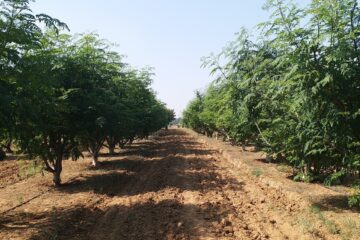Published in: April 2017.
One of the most widely cultivated fruits in the world is the grape. It is rich in Vitamin C. Grapes are consumed in various forms such as fresh fruit, juice, dried fruit, jam, and wine. Despite their numerous benefits, grapes are susceptible to several diseases, one of which is downy mildew. This disease affects grape production in all countries.
Downy Mildew Disease
This disease has been present in the United States as an endemic condition since 1870. In France, it appeared suddenly after 1875, causing significant damage. Currently, downy mildew is widespread in all grape-growing countries, causing extensive damage.
Symptoms of the Disease
All parts of the plant above ground are affected by this disease, particularly leaves, young stems, tendrils, and immature fruits. The first signs are irregular-shaped, light yellow spots on the leaf surface. On the underside of these spots, a soft, downy growth can be observed. As the disease progresses, the affected tissue becomes necrotic and the spots turn brown.
In severe cases, the spots enlarge and merge, causing the entire leaf to wither. The affected stems show stunted growth and swelling. White downy growth appears on infected leaves, tendrils, and stems. Some or all berries in a cluster may be affected, turning pale green or brown, shriveling, and rotting.
Grape vines can retain green leaves year-round, making downy mildew a permanent presence in vineyards. However, the disease becomes severe only under favorable weather conditions. The disease is initiated by dormant spores known as oospores.
These spores remain on the ground and, under favorable weather conditions, produce numerous motile spores. These attack the leaves near the ground and initiate the disease. The spores are then spread by wind, affecting all parts of the plant.
Control Measures: Agricultural Practices
Collect and burn fallen leaves, tendrils, and fruits affected by the disease. Ensure proper spacing between plants. Keep the leaves of the plants elevated from the ground. Maintain adequate airflow in the soil to prevent moisture buildup.
Chemical Control Methods
Spray the plants thoroughly with a solution of 0.6% Bordeaux mixture or copper oxychloride at 2.5 grams per liter of water, or any dithiocarbamate fungicide such as Zineb, Maneb, or Mancozeb at 2 grams per liter of water, or Captan fungicide at 1.25 grams per liter of water.
To effectively control the disease, spray 5-6 times a year. The first spray should be done at bud break, the second 3-4 weeks after the first, the third before flowering, the fourth when the berries are pea-sized, and the fifth during the growth period of the plants.
Dr. V.M. Srnivasan, S. Suguna, M. Daniel Jebaraj, Dr. P. Karthik, Father Rover Agricultural College, Perambalur – 621 115.










